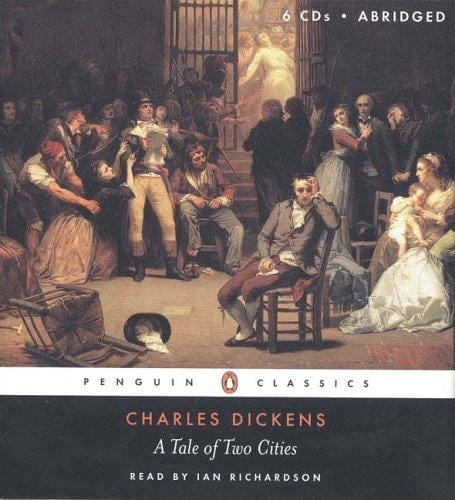A Tale of Two Cities (Penguin Classics): A Timeless Journey Through Revolution and Redemption
Explore why Charles Dickens’s A Tale of Two Cities, in the acclaimed Penguin Classics edition, remains essential reading for lovers of historical fiction and classic literature.

Introduction
Few novels capture the sweeping drama of history while probing the deepest corners of the human heart as powerfully as Charles Dickens’s “A Tale of Two Cities.” First published in 1859 and continuously in print ever since, this classic of Victorian literature chronicles the intertwined fates of London and Paris at the cusp of the French Revolution. The Penguin Classics edition has become the go-to version for students, educators, and lovers of literature who crave authoritative text, insightful notes, and an elegant reading experience. In roughly 800 words, this article explores why “A Tale of Two Cities (Penguin Classics)” remains essential reading in the twenty-first century.
Plot Overview
Set against the turbulence of the late eighteenth century, the novel follows several unforgettable characters: Dr. Alexandre Manette, freed after years of wrongful imprisonment in the Bastille; his devoted daughter Lucie Manette; Charles Darnay, a French aristocrat who rejects his family’s cruel legacy; and Sydney Carton, a brilliant but disillusioned English barrister. Dickens weaves their stories between London’s calm respectability and Paris’s revolutionary fervor, culminating in acts of sacrifice, resurrection, and love amid the Reign of Terror. The riveting final chapters—featuring Carton’s iconic declaration, “It is a far, far better thing that I do, than I have ever done”—cement the novel’s reputation as one of literature’s most moving finales.
Major Themes
The Duality of Cities and Souls
From its celebrated opening line—“It was the best of times, it was the worst of times”—Dickens underscores duality: light and dark, hope and despair, London and Paris. The parallel settings reveal how political turbulence can mirror inner conflict; peace in one city contrasts with chaos in another, just as serenity in one heart contrasts with turmoil in another.
Sacrifice and Redemption
At its core, “A Tale of Two Cities” is a meditation on self-sacrifice. Characters repeatedly relinquish personal safety and privilege for the welfare of others. Sydney Carton’s ultimate act of substitution embodies Christian and humanistic ideals of redemption, proving that even the most wayward soul can achieve moral greatness through love.
Class Struggle and Social Justice
Through unforgiving portraits of aristocratic cruelty and peasant suffering, Dickens critiques systemic injustice. He warns that societal oppression eventually ignites violent backlash, a lesson with enduring relevance in modern debates over inequality. The Penguin Classics notes enrich this theme by illuminating the historical context of prerevolutionary France and Victorian England.
Why Choose the Penguin Classics Edition?
Authoritative Text
Penguin Classics presents the novel as Dickens intended, drawing from the definitive Clarendon edition. Meticulous proofreading removes typographical errors that plague many budget reprints, ensuring clarity for today’s readers.
Insightful Introductions and Notes
The scholarly introduction, typically penned by a leading Dickensian, situates the work within Dickens’s career and nineteenth-century politics. Endnotes decode archaic idioms, French terminology, and historical allusions, empowering newcomers to appreciate nuances without constant web searches.
Portable Design
With durable binding, cream-colored paper, and readable typeface, the Penguin volume balances affordability and quality. Whether you are commuting on a train or curled up by the fireplace, the edition’s lightweight form factor makes immersive reading effortless.
Character Highlights
Sydney Carton
Often dismissed as a dissipated lawyer, Carton transforms into one of literature’s greatest heroes. His arc from self-loathing to self-sacrifice illustrates Dickens’s belief in the latent nobility of humankind. Penguin’s critical apparatus draws attention to biblical echoes and Shakespearean influences shaping Carton’s journey.
Charles Darnay
Darnay’s renunciation of his family’s oppressive wealth demonstrates moral courage, yet his aristocratic ties place him in mortal danger during the revolution. The tension between inherited guilt and personal virtue fuels much of the novel’s suspense.
Madame Defarge
Symbolizing implacable vengeance, Madame Defarge knits the names of intended victims into her relentless register. Her chilling resolve reminds readers that prolonged injustice can corrode empathy, birthing new oppressors among the once-oppressed.
Reading Experience and Style
Dickens’s prose is renowned for vivid imagery, melodrama, and razor-sharp social commentary. In “A Tale of Two Cities,” he adopts a more economical style than in sprawling works like “Bleak House,” making the novel accessible to reluctant classic readers. Short, punchy chapters accelerate momentum, while recurring motifs—echoes, footsteps, and shadows—create cinematic tension. Penguin’s layout accentuates these stylistic choices, with clear chapter breaks and ample margins for annotation.
Who Should Read This Book?
Students of world history will find a gripping narrative that humanizes textbook events; literature enthusiasts will savor Dickens’s craft; and book clubs will appreciate the moral dilemmas ripe for discussion. Moreover, fans of historical fiction from Hilary Mantel to Ken Follett can trace genre roots back to Dickens’s meticulous blend of fact and imagination. The Penguin Classics edition is particularly valuable for educators seeking a reliable text to assign, complete with resources that facilitate classroom debate and essay writing.
Tips for First-Time Readers
1. Skim the introduction after finishing the story to avoid spoilers yet maximize contextual insight.
2. Use the endnotes sparingly during your first read to maintain narrative flow, returning afterward for deeper understanding.
3. Read aloud select passages—Dickens wrote with performance in mind, and hearing the rhythms enriches appreciation.
Conclusion
More than 160 years after its debut, “A Tale of Two Cities” continues to resonate because it speaks to universal experiences of love, loss, injustice, and hope. The Penguin Classics edition amplifies these qualities, providing a reliable, enriching gateway to Dickens’s timeless vision. Whether you are revisiting the novel or opening its pages for the first time, this edition invites you to witness the tumbling guillotine, the crowded Old Bailey, and the quiet triumph of a single, redemptive act—reminding us all that even in the darkest eras, light and humanity endure.



